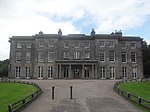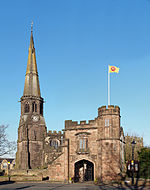
Thomas Littleton Powys, 4th Baron Lilford, was a British aristocrat and ornithologist.

Baron Lilford, of Lilford in the County of Northampton, is a title in the Peerage of Great Britain. It was created in 1797 for Thomas Powys, who had previously represented Northamptonshire in the House of Commons. His grandson, the third Baron, served as a Lord-in-waiting from 1837 to 1841 in the Whig administration of Lord Melbourne. He was succeeded by his son, the fourth Baron, an ornithologist.
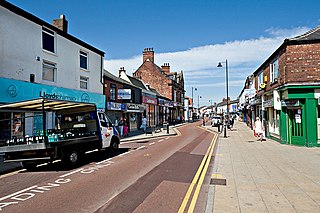
Atherton is a town in the Metropolitan Borough of Wigan in Greater Manchester, England and historically part of Lancashire. The town, including Hindsford, Howe Bridge and Hag Fold, is 5 miles (8.0 km) south of Bolton, 7 miles (11.3 km) east of Wigan, and 10 miles (16.1 km) northwest of Manchester. From the 17th century, for about 300 years, Atherton was known as Chowbent, which was frequently shortened to Bent, the town's old nickname. During the Industrial Revolution, the town was a key part of the Manchester Coalfield.
Thomas Powys, 1st Baron Lilford was a British politician who sat in the House of Commons from 1774 to 1797 when he was raised to the peerage as Baron Lilford.

Thomas Atherton Powys, 3rd Baron Lilford, was a British peer and Whig politician.
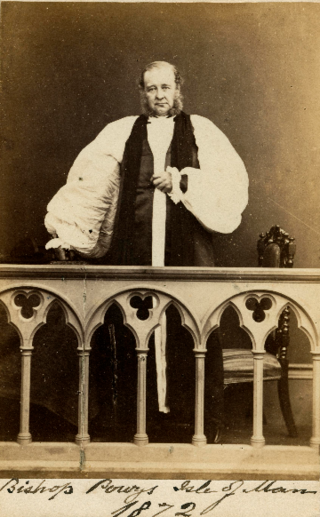
Horatio Powys was a priest in the Church of England and Bishop of Sodor and Man.
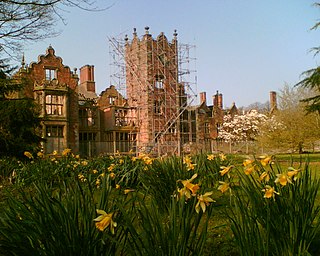
Bank Hall is a Jacobean mansion in Bretherton, Lancashire, England. It is a Grade II* listed building and is at the centre of a private estate, surrounded by parkland. The hall was built on the site of an older house in 1608 by the Banastres who were lords of the manor. The hall was extended during the 18th and 19th centuries. Extensions were built for George Anthony Legh Keck in 1832–1833, to the design of the architect George Webster.
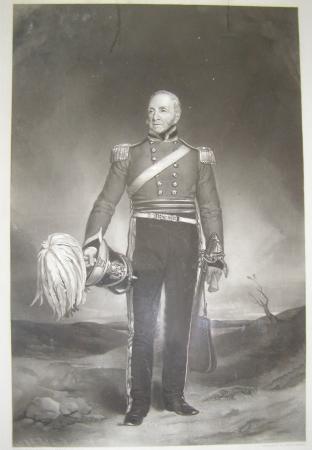
Colonel George Anthony Legh Keck, sometimes spelled Legh-Keck, was a British military officer, Tory politician and landowner who sat in the House of Commons representing the parliamentary constituency of Leicestershire from 1797 to 1831.

The Leghs of Lyme were a gentry family seated at Lyme Park in Cheshire, England, from 1398 until 1946, when the stately home and its surrounding parkland were donated by the 3rd Lord Newton to The National Trust.

Lilford Hall is a Grade I listed Jacobean stately home in Northamptonshire in the United Kingdom. The 100-room house is located in the eastern part of the county, south of Oundle and north of Thrapston.
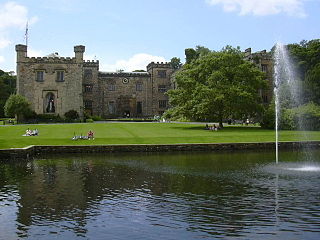
The Towneley or Townley family are an English family whose ancestry can be traced back to Anglo-Saxon England. Towneley Hall in Burnley, Lancashire, was the family seat until its sale, together with the surrounding park, to the corporation of Burnley in 1901. Towneley Hall is now a Grade I listed building and a large museum and art gallery within Towneley Park.
Fletcher, Burrows and Company was a coal mining company that owned collieries and cotton mills in Atherton, Greater Manchester, England. Gibfield, Howe Bridge and Chanters collieries exploited the coal mines (seams) of the middle coal measures in the Manchester Coalfield. The Fletchers built company housing at Hindsford and a model village at Howe Bridge which included pithead baths and a social club for its workers. The company became part of Manchester Collieries in 1929. The collieries were nationalised in 1947 becoming part of the National Coal Board.

Richard Legh was an English politician who sat in the House of Commons variously between 1656 and 1678.

Thomas Powys, 2nd Baron Lilford was a British peer. He was the son of Thomas Powys, 1st Baron Lilford and Mary Mann of Lilford Hall. He succeeded his father as Baron Lilford in 1800. He was educated at Eton College, St John's College, Cambridge and Lincoln's Inn (1794).
John Powys, 5th Baron Lilford, was a British peer and cricketer.

Stephen Powys, 6th Baron Lilford, was a British peer.
Stoughton Grange was a country house in the parish of Stoughton in Leicestershire and the family seat of the Farnham and Beaumont family. The house dated back to 15th century but was demolished in 1926, after being a successful family home for over five hundred years.

Robert Vernon Atherton Gwillym (c.1741–1783) was a British country landowner and politician who sat in the House of Commons from 1774 to 1780.

Bewsey Old Hall is a brick-built, three-storey, mainly Jacobean building, incorporating or reusing elements of a former medieval hall on the edge of Sankey Valley Park in Warrington, Cheshire. The estate was home to the Lords of Warrington from the 13th to the 17th century.
Sir Richard Atherton, was a Tory politician and an English Member of Parliament elected in 1671 representing Liverpool. He also served as Mayor of Liverpool from 1684 to 1685. He resided at Bewsey Old Hall, Warrington and died in 1687. He was 11th in descent from Sir William Atherton MP for the same county in 1381 and was the last Atherton in the male line to have been a member of parliament.
















